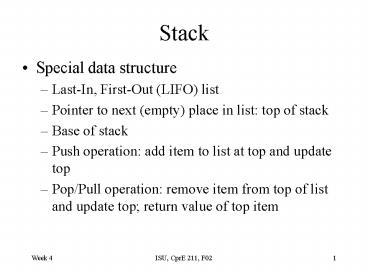Stack PowerPoint PPT Presentation
1 / 23
Title: Stack
1
Stack
- Special data structure
- Last-In, First-Out (LIFO) list
- Pointer to next (empty) place in list top of
stack - Base of stack
- Push operation add item to list at top and
update top - Pop/Pull operation remove item from top of list
and update top return value of top item
2
Stack
- Special block of memory
- Base - Usually initialized to a large address
- Stack usually grows toward lower addresses
- Push operation decrement top of stack
- Pop operation increment top of stack
- Top stored in a CPU register called the Stack
Pointer (SP) - GPR R1 in CodeWarrior
- SP is like a pointer variable in C it is the
address of the top of the stack
3
Stack
- Use of a stack
- Temporary storage during program runtime
- Not fixed in size grows and shrinks using push
and pop operations - Not typed elements of list not defined as one
type - Subroutines (functions, procedures)
- Linkage saving a link back to the caller
(address of calling routine) - Data return value, parameters, local variables
- Other saved information
- Managed at the assembly language level
- Rules for compiler, AL programmer
4
Stack
- Example
SP 0x7FFF SP points to top - next empty
location to push data to
5
Stack
- Example
Push 15 Takes up 1 byte on the stack SP is now
pointing to 0x7FFE (next location to push data to)
6
Stack
- Example
Push -3 Takes up 1 byte on the stack SP is now
pointing to 0x7FFD (next location to push data to)
7
Stack
- Example
Push 0x1808 0x1808 is a 16-bit value Takes up
two bytes on stack Pushed LSB, then
MSB Why? Little Endian LSB is at higher
address Stack grows toward lower addresses SP
is now 0x7FFB
8
Stack
- Example
Pop a byte value Update SP first by
incrementing, then read value Value read
0x18 SP is now 0x7FFB
9
Stack
- Example
Pop a half-word value Update SP, read MSB, read
LSB Value MSB, LSB 0x08, 3 0x08,
0xFD 0x08FD SP is now 0x7FFE
10
Stack
- Pushing and Popping
- Should be symmetric what goes on, must come off
- When you pop an item from the stack, the value is
still there in memory (i.e., it is not cleaned
out) - Declare local variables in C - initial values are
whatever was left on the stack - Stack does not know that a byte is part of a
32-bit, 16-bit, or 8-bit value - For PPC, stack grows minimum /- 4 bytes at a
time - Word alignment is enforced, where word boundaries
have addresses with least-significant nibbles of
0, 4, 8, C - SP assigned word-aligned addresses only,
incremented and decremented by a minimum of 4
bytes
11
Stack
- Notes - section 4.6
- Assembly language view of the stack
- Revisit again later
- Selected topics
- Subroutine linkage using Link Register
- Nested subroutines
- Local variables
12
Stack
- Subroutine call and return
- LR Link Register
- Call Do_Tasks
- Return address in main
- RA saved in LR
- Inside Do_Tasks
- Call Do_Calc
- Return address in Do_Tasks
- Saved?
- Need to use stack
main () int j Do_Tasks () Do_Tasks2
() void Do_Tasks () ... fResult
Do_Calc(15) ... float Do_Calc (float
fNum)
13
Stack
14
Stack
- Local variables
- long lVal
- char byVal
- char szName10
- Total Space 4 1 10 15 bytes
- Decrease SP by 16 to make space
- Why 16 bytes?
- PowerPC is word-aligned
- Need to keep stack pointer at an even multiple of
4 bytes
15
Stack
- Local variables
16
Rules
- EABI Embedded Application Binary Interface
- Specifies the interface between compiled
application programs and the processor - API how software is used in applications
- ABI how hardware (or low-level software) is used
in applications - Reduce memory usage and optimize execution speed
- Describes conventions for register usage,
parameter passing, stack organization, small data
areas, object file, and executable file formats
17
Rules
- Data types and alignment
- All data types are aligned in memory on addresses
that are a multiple of their size - Word-aligned Since size is 4 bytes, a word is
aligned on an address evenly divisible by 4
18
Rules
- Register usage conventions
- Will learn more later about processor registers
in assembly language programming
Recall GPR Register View in CodeWarrior R
General PurposeF FloatsCR Conditions
19
Rules
- Stack frame
- Organizes or delineates a functions stack space
- Supports parameter passing, register
preservation, local variables, and code debugging - Place various data into a stack frame in a
consistent manner - Important for functions that call other functions
(calling chain) - SP always points to the lowest addressed word of
the currently executing functions stack frame.
20
Rules
- Stack frame
- New frame is created adjacent to the most
recently allocated frame lower in memory
(pushed). - Creation decrement the SP just once, in the
function prologue, by the total amount of space
required by that function - store-with-update (stwu) instruction insure the
SP update is an atomic operation that cannot be
interrupted - Removed in the function's epilogue by adding the
current stack frame size to the SP before the
function returns to the calling function
21
Rules
- Stack frame example
22
Rules
- Stack frame example
LR Link Register, stores return address of caller
23
Rules
- Parameter passing
- For PowerPC processors, it is more efficient to
pass arguments (parameters) in registers than
using memory. - Up to eight scalar values are passed by using R3
through R10 - Return values are passed back in R3 and R4

